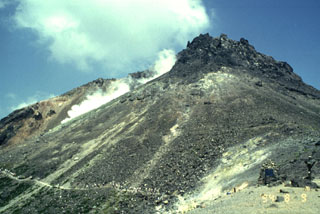Report on Nasudake (Japan) — March 1977
Natural Science Event Bulletin, vol. 2, no. 3 (March 1977)
Managing Editor: David Squires.
Nasudake (Japan) Earthquake swarm with felt events
Please cite this report as:
Global Volcanism Program, 1977. Report on Nasudake (Japan) (Squires, D., ed.). Natural Science Event Bulletin, 2:3. Smithsonian Institution. https://doi.org/10.5479/si.GVP.NSEB197703-283150
Nasudake
Japan
37.125°N, 139.963°E; summit elev. 1915 m
All times are local (unless otherwise noted)
An earthquake swarm including felt shocks occurred on 30-31 January, but no surface phenomena were observed.
Geological Summary. The Nasudake volcanic group consists of a N-S-trending cluster of stratovolcanoes and lava domes at the north end of the Kanto Plain. Volcanic activity dates back about 500,000 years. Growth of three large basaltic-to-dacitic stratovolcanoes, each lasting about 200,000 years, was followed by construction of three smaller andesitic stratovolcanoes, Asahidake, Futamatayama, and Chausudake. Activity during the last 55,000 years included the collapse of Asahidake volcano about 30-40,000 years ago, producing the massive Ofujisan debris-avalanche deposit, which covers a broad area SE of the volcano. The youngest volcano, Chausudake, began forming about 16,000 years ago. Six magmatic eruptions took place since then, the latest in 1408-1410 CE, when the Chausudake summit lava dome formed. These eruptions produced block-and-ash flows and concluded with the extrusion of lava flows. Smaller phreatic eruptions have occurred every few hundred years during the past 5,000 years.
Information Contacts: JMA, Tokyo.

